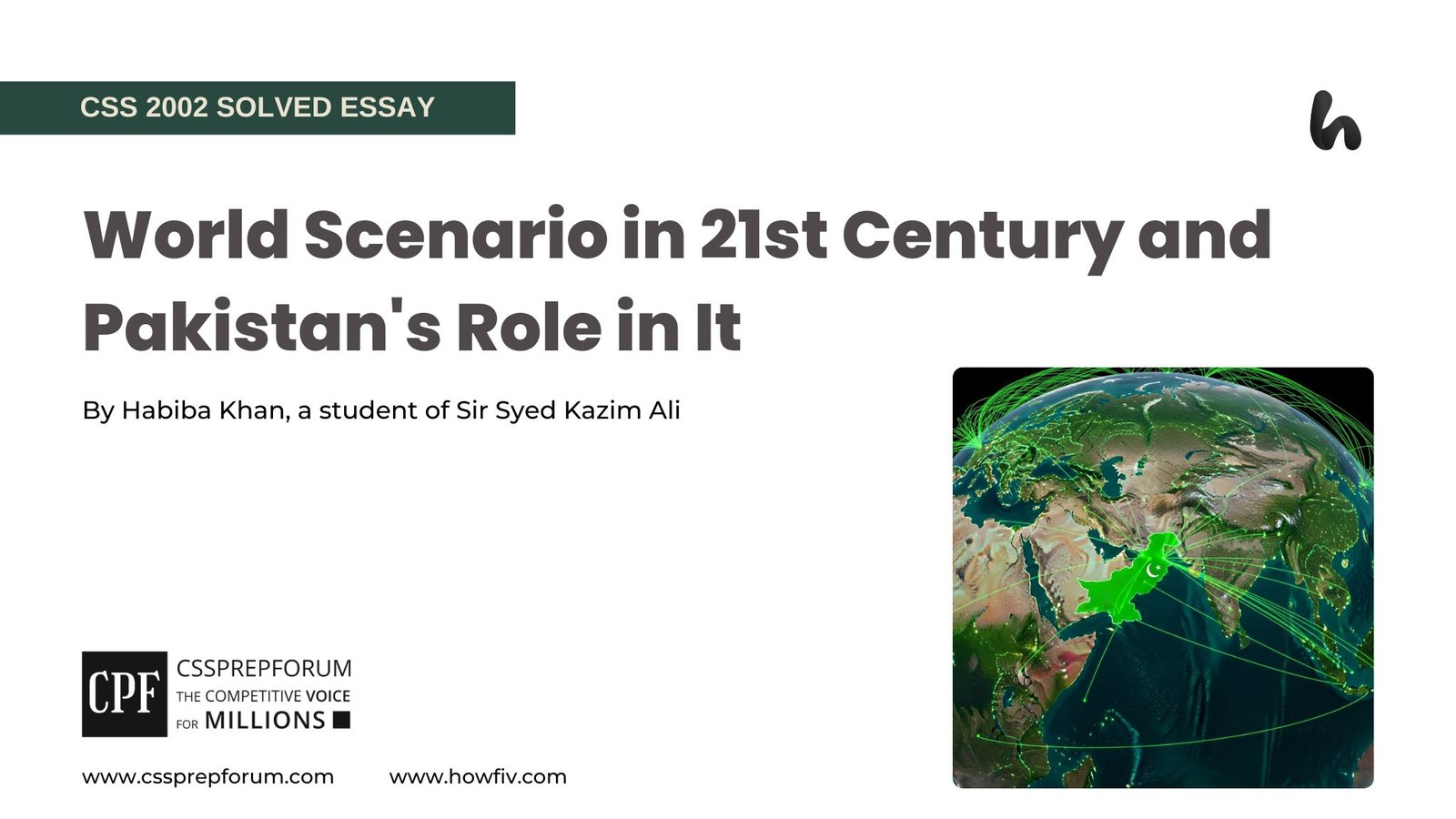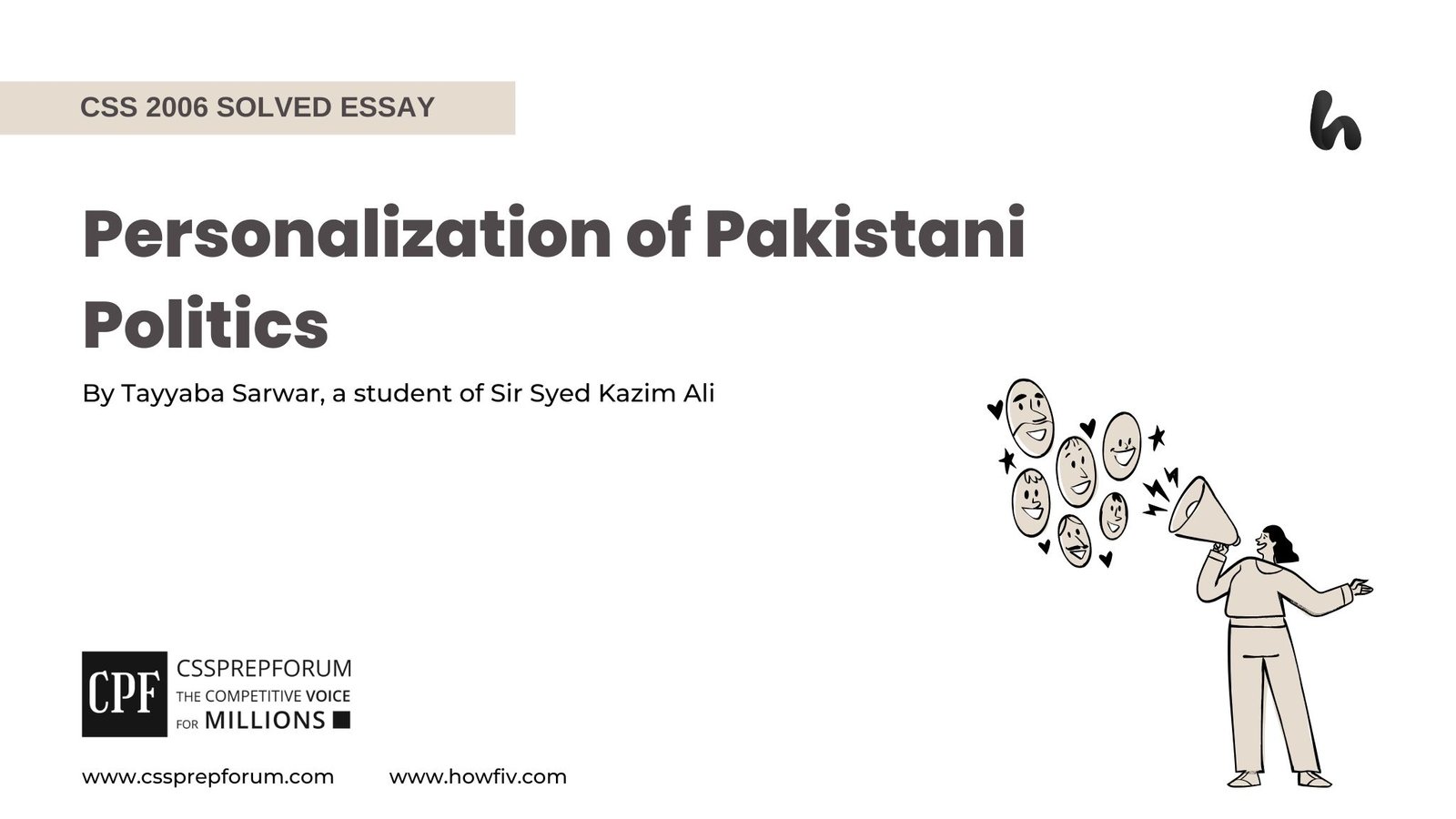Role of Energy Policies in Pakistan’s Current Energy Crisis| Daily Writeup | Opinions
The following article of CSS Pakistan Affairs is solved by Shadab Jabbar under the supervision of Howfiv’s Pakistan Affairs Coaches. She learnt how to attempt 20 marks question and essay writing from Sir Syed Kazim Ali, Pakistan’s best CSS and PMS English essay and precis teacher with the highest success rate of his students. This solved past paper question is attempted on the pattern taught by Sir to his students, scoring the highest marks in compulsory and optional subjects for years, and uploaded to help aspirants understand how to crack a topic or question, how to write relevantly, what coherence is, and how to include and connect ideas, opinions, and suggestions to score the maximum.

Outline
1- Introduction
2- Genesis of the energy crisis
3- Critical overview of the current situation
4- Pakistan’s energy policies over time
5- Shortcomings of the energy policies aiding the contemporary energy crisis
- ✓The trend of ad hoc policies
- ✓Over-reliance on energy imports
- ✓Insufficient political will and strategic comprehensiveness
- ✓Infiltration of the IPPs
6- Repercussions of the deficiencies in the historical energy policies
- ✓Over-piling circular debt
- ✓Elevated inflation and poverty
- ✓Deteriorated industrial and agricultural sectors
7- Solutions to the current energy crisis
8- Conclusion

Answer to the Question
1- Introduction
The energy sector is one of the most significant pillars upon which a country’s economic prosperity and sustainable development depend. States that grapple with energy crises face challenges in all development races. Unfortunately, Pakistan has been facing an economic crisis since the 1990s. According to the Statista Research Department, nearly 12 million people in Pakistan lack electricity. The roots of the crisis, for the most part, are embedded in the vulnerabilities of the historical energy policies put forth by different governments. Although it cannot be denied that multiple attempts have been directed towards the solution of the problem, these attempts are characterized by persistent neglected flaws: ad hoc policies that lack comprehensiveness, delayed implementation led by insufficient political will, and dependence on nonindigenous energy resources and IPPs (Independent Power Producers). Furthermore, these elements have significantly contributed to the exacerbation of the power crisis and impediment of economic development in the form of circular debt, poverty, inflation, and reduced agricultural and industrial activities. However, the prospects for tackling the crisis lie in pragmatic measures like technocratic policy formulation, investment in tapping domestic energy resources, and institutional reforms.
2- Genesis of the energy crisis in Pakistan
Ever since the inception of Pakistan in 1947, the energy sector developed gradually to meet the demand with limited resources. The country was left with a mere 60 MW (Megawatts) of installed power capacity. Even though at the initial stage, a little improvement was seen in the sector, it was short-lived. Currently, the majority of the citizens lack or have restricted access to electricity, and the only fuel that is readily available is costly transport fuel. This has resulted in a perpetual state of energy crisis driven by the constantly increasing energy demand and fuel crisis. Although the current energy crisis is attributed to the year 2007, its roots lie in the policy decisions made in the late 1990s. The initiation of two large-scale projects in the 1970s, the Mangla and Tarbela dams, led to economic expansion. As a result, the demand for energy increased, which the government of the time failed to meet due to various challenges. Moving forward, in 1994, the country faced power shortages, with only 40% of the population having access to electricity. Finally, in 1994, a power policy was formulated. However, since the origin of the energy crisis in Pakistan, the governments have not been successful in meeting the energy demand, which has been increasing due to factors like population explosion, urbanization, seasonal requirements, etc.
3- Critical overview of the current situation
As of May 2024, the summer heat waves have reached well over 40 degrees Celsius, and the entire nation is struggling with chronic power disruptions. Reports suggest that the power demand has risen to 24,500 MW while the output falls short at 18,655 MW. As a result, the national electricity gap has reached 5,845 MW. Hydropower produces 5,000 MW, government-owned thermal power facilities produce 975 MW, the Independent Power Producers (IPPs) generate 8,350 MW, wind produces 790 MW, solar power facilitates 200 MW, the bagasse supplies 140 MW, and about 3,200 MW are added to the national grid by nuclear power facilities. Furthermore, the gap has led to severe load-shedding, reaching over 8 hours in the rural areas and over 6 hours in the urban areas. The energy shortfall has had serious consequences for the country. It has resulted in not only inconveniences on social and domestic levels only, but also negative impacts on the corporate sector.
4- Pakistan’s energy policies over time
Throughout the years, numerous policies have been laid down by the Government of the Islamic Republic to bridge the energy gap. Since Pakistan is a developing country with various vulnerabilities spread across the economic sector, well-formulated and well-implemented energy policies are directly related to the overall progress of the nation. However, the power strategies of the country, over time, have been dispersed across several sub-policies without a unified text. There has been a practice of simultaneous introduction of numerous policy documents, including the National Plan 1994, the Power Generation Policy 2002, the Natural Gas Allocation and Management Policy 2005, the National Energy Conservation Policy 2006, the Petroleum Exploration Policy 2012, and Alternative and Renewable Energy Policy and the National Electric Vehicle Policy of 2019. One of the reasons for the policy dispersion is the division of the sector, the participation of various organizations, departments, and ministries, and the lack of cooperation between them.
5- Shortcomings of the energy policies aiding the contemporary energy crisis
- ✓The trend of ad hoc policies
Pakistan has lagged in developing a consistent pattern of long-term growth since its founding in 1947. The five-year governing term is rather short for the ruling actors, and they have to choose between investing in initiatives that would have long-term benefits and spending short-term on poorly planned initiatives that would impress the electorate. Unfortunately, the latter has remained the trend in the country. Similarly, almost every administration has handled the energy sector in an ad hoc manner. The idea of sustainable and long-term energy planning has always remained foreign. The panicked decision to establish the IPPs according to the investors’ specifications in 1994 is a glaring example of ad hocism in energy policies. This measure has turned out to be harmful to the energy sector in the long run, given the constantly increasing tariffs and drainage of resources.
- ✓Over-reliance on energy imports
The energy policies of the Islamic Republic have not been successful in reducing its dependence on energy imports. The country largely relies on imported power resources even though it has abundant indigenous natural resources, and about 64% of its population consists of youth. According to the Energy Outlook 2030 Report of the Central Asia Regional Economic Cooperation Programme (CAREC), Pakistan produces energy mostly from coal, natural gas, and oil. However, nearly 40% of the major energy source is imported. Despite having indigenous resources such as coal in Sindh, Balochistan, and Punjab, the debt of the country keeps piling up because of the costly imports. Additionally, whenever the energy prices in the global market hike, Islamabad has to keep up with the hefty payments, and the nation faces power outages.
- ✓Insufficient political will and strategic comprehensiveness
Among the primary characteristics of the historical energy policies of Islamabad that have contributed to the existing energy crisis is a stagnant political will to counter the challenges and an overall lack of comprehensiveness in the formulation of the strategies. Hence, the country’s disorganized policies have not succeeded in addressing the underlying causes of the crisis, and it has yet to draft a thoroughly integrated power strategy. Furthermore, the various progressive initiatives have not yielded outcomes given the insufficient political determination. For instance, in 2010, the country unveiled a National Energy Plan, which largely comprised widely ridiculed and disregarded conservation measures: mandatory early street market closure, a ban on neon billboards, and all-night wedding celebrations. Nevertheless, the proposal was neither well thought out nor properly implemented. In contrast, the Asian Development Bank created a comparatively more realistic and achievable conservation plan in 2012 by providing twenty million low-energy light bulbs.
- ✓Infiltration of the IPPs
The energy policies of Pakistan paved the way for the infiltration of the Independent Power Producers in the energy sector. The short-sighted approach during the signing of the energy contracts of 1994, 2002, and 2014-2015 and these agreements themselves were never investigated. The policies overlooked the unjust terms and negative consequences of the contracts for the country and its people. Hence, the country now faces astronomical charges due to these agreements, which have also brought up challenges regarding accountability, transparency, and the general administration of the power sector. Under the IPP contracts, Pakistan is bound to pay these actors whether or not the power plants are running. The IPP Enquiry Report 2020 by the Government of Pakistan revealed the enormous profits these corporations were making, between 200 to 300 billion PKR, despite the abysmal investment of just 57 billion PKR. In addition, these companies got fuel payments totalling billions of rupees. Nevertheless, there has been a steady increase in electricity rates despite the government’s provision of over 900 billion PKR subsidies to the IPPs. Consequently, this has contributed to worsening Pakistan’s energy crisis by shifting a significant chunk of circular debt to the consumers.
6- Repercussions of the deficiencies in the historical energy policies
- ✓Over-piled circular debt
In Islamabad’s energy sector, the phrase “circular debt” has evolved to signify the spiralling pattern of nonpayments and the whole energy supply chain. The inefficient energy policies and other structural and administrative lags have made the issue of debt circularity a recurring concern for the country. The estimates in the Power Division’s Debt Report indicate that compared to the circular debt of 2.31 trillion PKR at the end of FY23 (fiscal year 2023), Pakistan’s power sector circular debt in the initial seven months of FY24 has increased by 325 billion and is predicted to amount to 2.635 trillion PKR by the end of the year. This situation has been exacerbated by mismanaged subsidies, which are meant to lower the cost of electricity for consumers; however, the attempts to protect the public from skyrocketing energy costs have resulted in financial burdens on the power sector. The discrepancy between the cost of producing and delivering power and the generated revenue increases and contributes to the circular debt when subsidies are not distributed in an effective manner.
- ✓Elevated inflation and poverty
The inflation and poverty rates in Pakistan have gone up as a result of the energy crisis. Many individuals have been laid off or have had their wages cut as a result of power cuts and the ensuing economic crisis. As per the World Bank’s Development Report, about 40% of Pakistan’s population now lives below the line of poverty, and the country’s economy will expand by only 1.8% in FY24. Among other commodities, there has been a significant hike in the prices of petrol, diesel, and gas on the global level, which has led to inflation in Pakistan, resulting in financial pressure on consumers and an environment of economic anxiety. According to the World Economic Outlook 2024, the inflation rate in the country is about 24.8%. The increased poverty and inflation rates are correlated with the energy sector of Islamabad. Up to 15-20% of the total income of a standard household is consumed by electricity bills, whereas in recent years, the middle class saw a 30% decline in their purchasing ability. A significant portion of these problems are attributed to the surge in energy costs, the country’s dependence on energy-related imports, and power shortages.
- ✓Deteriorated industrial and agricultural sectors
The existing energy crisis, which is largely a contribution to Pakistan’s defective energy policies, has had an adverse impact on the country’s agriculture and industries. According to the Labour Force Survey 2022, about 29% of Pakistan’s population that is employed works in industries contributing around 25% to the GDP and consuming 28% of total electricity. Meanwhile, the agricultural sector comprises 38.5% of the labour force, making up 20% of the GDP, and electricity consumption is 9%. The heavy load shedding in the country has affected the performance of both sectors. The fertilizer and textile companies have been hit the worst. Even though Pakistan has the potential to produce urea not only sufficient for itself but also in surplus to be exported, the disruption in gas supply has compelled the state to buy urea instead. For instance, as of May 2024, the country’s Economic Coordination Committee approved the import of about 200,000 tonnes. This has resulted in a high cost of fertilizer, which is very important for agriculture. Additionally, most of the irrigation in the country is made possible by tube wells that are powered by electricity. Due to the power shortage and high energy cost, the irrigation of the crops is not sufficient. As a result, hundreds of acres of fertile land in Pakistan have dried up. This also leads to low crop yield and increased costs of agricultural products, which has ultimately resulted in food insecurity.
7- Solutions to the current energy crisis
- ✓Technocrats should be made a stronger part of the policy-making process. The field experts and professionals can make better, visionary, and comprehensive policies sans the pressure of having an impact on a vote bank.
- ✓Investments should be directed towards realizing a more balanced energy mix comprising indigenous non-renewable and renewable energy resources. Pakistan has great potential for generating energy from indigenous coal and solar power.
- ✓Strong implementation and accountability mechanisms must be established under a unified body that consolidates all the scattered departments, organizations, and ministries within the power sector.
8- Conclusion
In sum, Pakistan has been struggling to regulate its energy sector efficiently since its birth. Despite numerous efforts by the different governments throughout the years, the energy crisis in the country has persisted. This has manifested in limping progress in the financial sector and a state of economic anxiety among its citizens. The high energy costs have rendered the population unable to afford much, and the poorly managed subsidies have burdened them with circular debt. Furthermore, the crisis has caused a decline in productivity in the agricultural and industrial sectors, leading to further reliance on imports of commodities that could be produced in the country under favourable energy conditions. Most of these challenges are attributed to the overlooked loopholes in the energy policies of Islamabad, tainted with factors like the vested interest of the politicians, poor planning, and overreliance on foreign means for power generation. Nonetheless, there is much room for improvement in the sector through long-term policy formulation, exploration of untapped indigenous energy resources, and a system that ensures implementation and accountability.

CSS Solved Past Papers’ Essays
Looking for the last ten years of CSS and PMS Solved Essays and want to know how Sir Kazim’s students write and score the highest marks in the essays’ papers? Then, click on the CSS Solved Essays to start reading them.
CSS Solved Essays
CSS Solved General Science & Ability Past Papers
Want to read the last ten years’ General Science & Ability Solved Past Papers to learn how to attempt them and to score high? Let’s click on the link below to read them all freely. All past papers have been solved by Miss Iqra Ali & Dr Nishat Baloch, Pakistan’s top CSS GSA coach having the highest score of their students.
General Science & Ability Solved Past Papers












